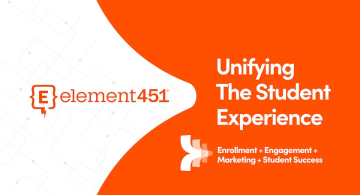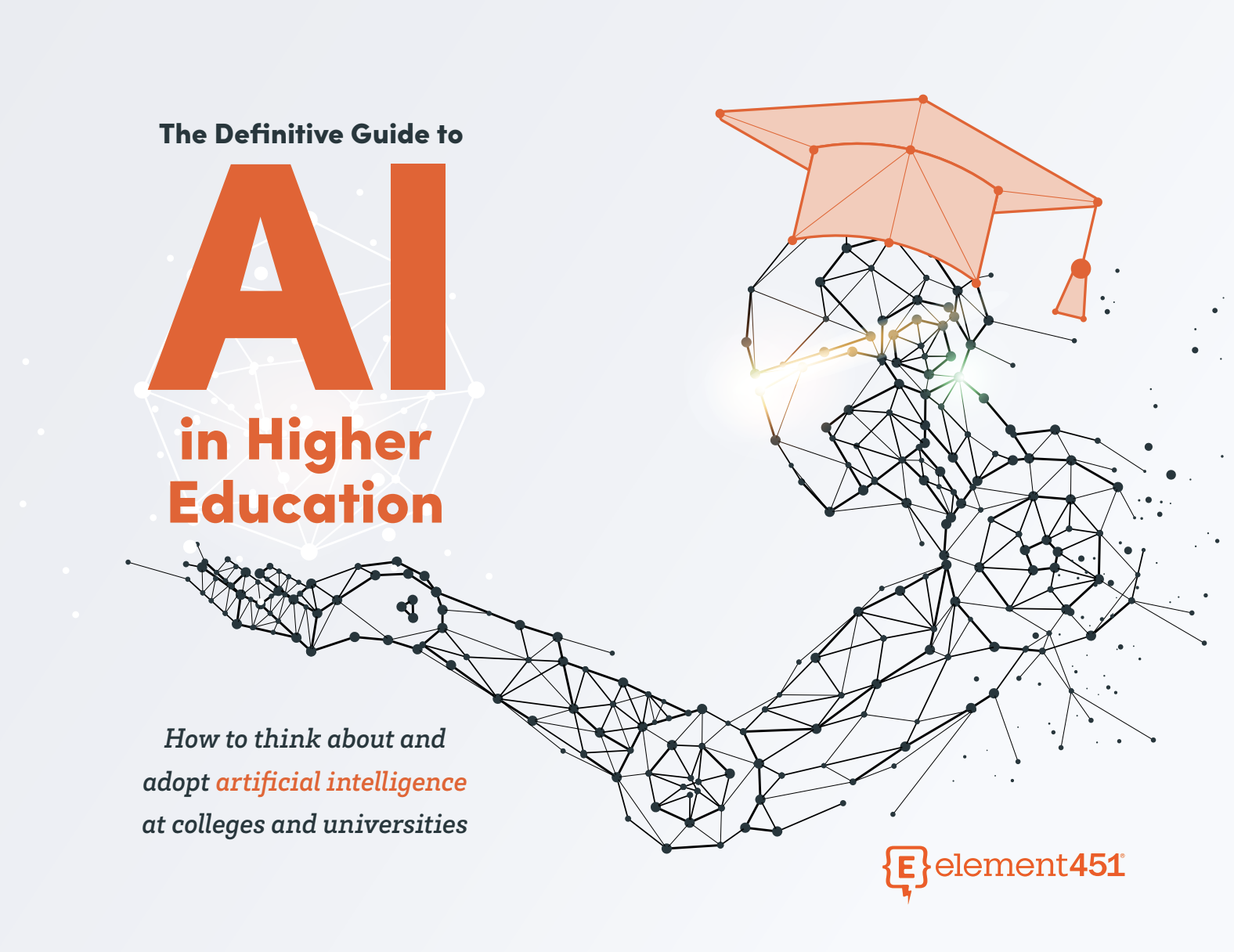Beyond ChatBots: How Proactive AI Agents Will Drive the Next Wave of Student Engagement
by Ardis Kadiu · Updated Oct 15, 2024
Artificial intelligence (AI) is evolving rapidly, with one of the most recent advancements being the transformation of basic reactive systems, like chatbots, into more advanced and capable AI agents. Agents are AI systems that can take action by understanding data and context, making decisions autonomously, and even taking action without being prompted. Agents are true “AI team members” that will work alongside human teams to bring out the best in both human creativity and technological efficiency. In higher education, where student engagement and academic success are critical, AI agents are becoming indispensable. Higher ed institutions simply have more work available than they can ever possibly complete, and are struggling mightily to connect to students in meaningful ways. AI agents are the only solution.
How We Got Here: The Evolution of AI Agents
In 2022, advancements in Large Language Models (LLMs) made it possible to create natural language software interfaces such as ChatGPT, ushering in a new era of AI innovation. These advancements made it easier than ever to generate content with AI systems, to learn from them, and to solve problems with them.
Now, the industry is going beyond first generation AI tools like chatbots, and building advanced AI agents capable of handling more complex workflows, learning from patterns, and anticipating user needs just like a person.
The recent history of AI innovation:
- Spring 2023: Element451 launched BoltBot, a classic AI chatbot designed to automate student queries and streamline communication.
- Summer 2023: Element451 introduced the Campaign Copilot, an AI agent that took automation a step further, allowing for more decision-based tasks like automating personalized communication workflows and marketing campaigns.
- Fall 2023: Hubspot introduced Chatspot.ai, their generative AI tool integrated with their CRM platform. Salesforce launched Einstein Copilot, a similar system integrated directly with the Salesforce CRM.
- Spring 2024: Element451 introduced a full suite of Bolt AI Assistants, the first team of AI agents optimized for higher ed. AI Assistants pull from institutional data, interact with other systems, and execute tasks autonomously—such as guiding students through the application process, scheduling advising sessions, or managing event registrations.
- Fall 2024: Salesforce introduced AgentForce, their AI agent suite. AgentForce is an evolution of their AI toolkit that builds on their CRM platform, enabling businesses to deploy agents for complex cross-system tasks. And HubSpot launched agents.ai, a platform for creating and distributing agentic AI systems that integrate with their CRM.
At Element451, we’re continuing to push the boundaries even further with our development of Proactive AI Agents, designed to take action before a student even reaches out for help. By anticipating needs and delivering support in real time, we continue to stay ahead of the innovation curve. But more about that later.
What is a Proactive vs. Reactive AI Agent?
To date, AI agents have predominantly been reactive in nature. They wait for a user’s input, process the request, and then provide a response or execute an action based on predefined rules or learned behaviors. Chatbots and virtual assistants are common examples of reactive AI agents—they help with tasks like answering FAQs or scheduling appointments, but only after being prompted by the user.
Proactive AI agents, however, represent a more dynamic approach. These AI agents don’t just respond—they reason. Designed to operate continuously in the background, they autonomously analyze vast amounts of data, understand patterns, and make informed decisions based on user behavior, context, and goals. They can reason through data and take action based on learned insights, without waiting for explicit user input.
In turn, proactive AI agents can provide personalized communications at scale—without being prompted. For example, instead of a student having to ask for help with an upcoming exam, an AI agent can analyze their academic data, identify potential struggles, and send encouraging messages, offer study resources, or suggest tutoring—all before the student even recognizes they need help.
Proactive AI agents also don't just work alone—they collaborate as a team to achieve common goals. For instance, one agent can guide a student through the admissions process, while another ensures their financial aid is completed.
This orchestration allows institutions to provide highly personal, real-time support to each student, enhancing both the student experience and institutional efficiency. Whether it's nudging a student to prepare for an upcoming exam, guiding them through registration, or ensuring they attend orientation, proactive AI assistants work as a cohesive team—achieving goals faster and with greater precision than reactive systems ever could.
Understanding the AI Stack
To fully grasp the innovation that proactive AI agents represent, it’s helpful to think about the AI platform stack. Similar to how traditional software stacks—composed of databases, servers, and front-end interfaces—form the foundation of digital systems, the AI stack builds upon each layer to unlock greater functionality and sophistication.
Here's a breakdown of how we think about the AI technology stack at Element451:
- Layer 1: The Brain (Large Language Models, or LLMs)
At the core of the AI stack is the "brain," powered by Large Language Models (LLMs). This is where reasoning happens. In the past, chatbot systems were deterministic—working on basic “if-then” logic. But with LLMs, AI systems can process language and data in a much more conversational, human-like manner. For example, these models can understand a student’s query about financial aid or admissions and respond with contextual accuracy. It’s the foundation that allows agents to "think" and respond meaningfully based on prompts. - Layer 2: Memory and Context
Beyond the brain, AI systems require memory and context to deliver nuanced, back-and-forth interactions. This layer ensures that the system retains previous interactions and data points, providing a deeper understanding of the user. For example, if a student had previously asked about application deadlines, the AI can reference that history and adjust its responses accordingly. It’s this memory layer that brings continuity to interactions, pulling from stored knowledge bases, user profiles, and institutional data to provide richer, more relevant answers. - Layer 3: Skills and Tools
Next comes the skill layer, which enables AI agents to take action based on user requests. Imagine a prospective student asking an AI agent to schedule a campus tour. The agent taps into its scheduling tools, interacts with the calendar, and books the event. Or if a student is applying for financial aid, the AI agent pulls the necessary forms and helps the student fill them out. The ability to "do" things is essential, and it’s at this level that AI agents become more than just conversational assistants—they become proactive digital workers that can complete tasks. - Layer 4: Orchestration and Personalization
The top layer is where orchestration comes in—agents work together, coordinating across various domains to handle complex workflows. Just as a human advisor might refer a student from financial aid to admissions, AI agents can seamlessly pass the task from one to another. This orchestration allows for smooth transitions between tasks, ensuring that no matter where a student’s needs lie—whether academic advising or housing support— teams of AI agents can provide a coordinated response. This layer also allows for deep personalization, tailoring the student experience to each individual’s journey.
Each layer builds on the next to create intelligent systems that not only respond to questions but also predict needs, offer guidance, and even take actions on behalf of users. It's this structure that underpins the next generation of proactive AI agents, enabling seamless, intelligent, and personalized interactions at every step of a student’s journey.
How Proactive AI Agents Can Transform Higher Education
The higher education sector is on the verge of a major transformation with the introduction of Proactive AI Agents. By transitioning from reactive systems that respond to student requests to proactive systems that anticipate needs and deliver timely support, institutions can improve student engagement, retention rates, and overall academic success.
Jessica's Journey: From High School to Alum with AI-powered Support
To illustrate the potential, let’s follow Jessica, a student at Southeast Missouri State University (SEMO), and explore how Proactive AI Agents can guide her every step of the way—from high school senior to alum.
1. Personalized Admissions Guidance
As a high school senior, Jessica begins her journey by exploring SEMO. Instead of navigating the admissions process on her own, she is supported by a Proactive AI Agent. The agent reaches out via SMS, reminding her about key admissions deadlines and guiding her through the application process. It also answers her questions in real-time, whether she’s asking about scholarships, academic programs, or campus life.
When Jessica is applying for financial aid, the Proactive AI Agent reviews her financial profile and suggests relevant scholarships and grant opportunities. It also tracks the status of her FAFSA application, sending her reminders about any missing documents. By offering these personalized touch points, the Proactive AI Agent makes the admissions process less overwhelming and ensures that Jessica stays on track.
2. Transition into College Life
After being accepted, Jessica’s journey continues as she transitions from a high school student to a freshman at SEMO. The Proactive AI Agent doesn’t disappear—it evolves to support her as she navigates new challenges. During orientation, the agent recommends clubs, organizations, and academic support services based on Jessica’s interests and major. It automatically schedules advising sessions and helps her enroll in courses.
When Jessica needs assistance, whether it's registering for classes or understanding financial aid options, the AI agent is there to provide on-demand support. The proactive nature of the agent ensures that Jessica doesn’t have to seek help—it’s always there, anticipating her needs and offering personalized solutions.
3. Academic Support
Once Jessica begins her first semester, the Proactive AI Agent continues to monitor her progress. For example, after noticing a dip in her grades in a math course, the AI agent steps in. Without Jessica having to ask for help, it recommends tutoring services, sends reminders about upcoming assignments, and even schedules office hours with her professor—all within the platforms she uses most, whether that's email, text, or the university’s mobile app.
This personalized attention helps Jessica stay on track academically and provides support before her performance suffers significantly. By addressing problems early, the Proactive AI Agent improves her chances of success and increases retention rates for the institution.
4. Continuous Engagement as an Alum
Even after Jessica graduates, her relationship with SEMO continues. As an alum, she receives tailored updates from the Proactive AI Agent about continuing education opportunities, career development resources, and alumni events. The agent can also identify opportunities for Jessica to engage with her alma mater, such as mentoring current students or attending networking events, keeping her connected long after graduation.
Proactive Support Across Channels
One of the key strengths of Proactive AI Agents is their ability to engage students across multiple platforms. Whether it’s through SMS, email, or app notifications, the agent can seamlessly reach Jessica on the channels she prefers. This omni-channel engagement ensures that students like Jessica are supported in real time, no matter where they are or what device they’re using.
By offering personalized, timely assistance at every stage—from high school to alum—Proactive AI Agents ensure that students remain engaged, supported, and connected throughout their educational journey.
The Future of Personalized Student Journeys is Only Possible with AI
Proactive AI agents are the next frontier in student engagement, offering personalized, real-time support that can dramatically improve academic outcomes and student satisfaction. Institutions that stay ahead of the curve will have the ability to deliver truly personalized experiences that support the needs of students.
As we look ahead, it’s clear that Proactive AI agents are set to redefine the student experience. In our next post, we’ll explore how forward-thinking institutions are looking to adopt AI agents to revolutionize their student engagement strategies, and what the future holds for AI in higher education.

About Element451
Boost enrollment, improve engagement, and support students with an AI workforce built for higher ed. Element451 makes personalization scalable and success repeatable.
Categories
New Blog Posts

The Definitive Guide
AI in Higher Education
Bridge the gap between the latest tech advancements and your institution's success.
Useful Links

Talk With Us
Element451 is the only AI Workforce Platform for higher education. Our friendly experts are here to help you explore how Element451 can improve outcomes for your school.
Get a Demo








